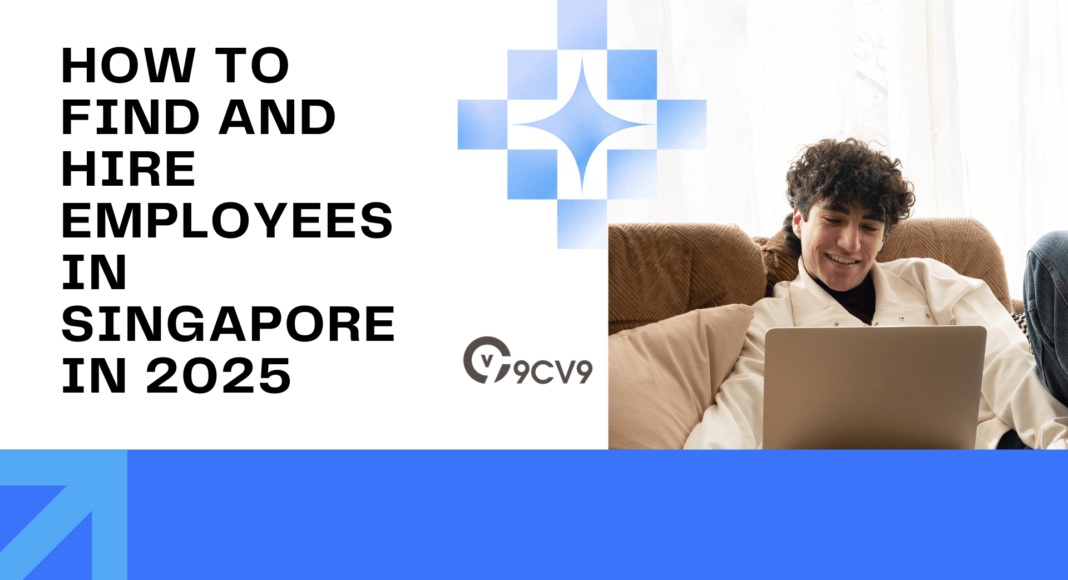Key Takeaways
- Leverage Diverse Recruitment Channels: Use job portals, social media, recruitment agencies, and networking events to access Singapore’s rich talent pool and stay competitive in the 2025 hiring market.
- Understand Legal and Administrative Requirements: Ensure compliance with Singapore’s labor laws, including employment contracts, work pass regulations, and fair hiring practices, to streamline your recruitment process.
- Focus on Retention Strategies: Retain top talent through competitive compensation, career development opportunities, and a positive workplace culture, essential in Singapore’s competitive job landscape.
As we step into 2025, Singapore’s dynamic and ever-evolving job market continues to be a hub for innovation, diversity, and growth.
Renowned as a global business epicenter, Singapore is not only a magnet for multinational corporations but also a nurturing ground for startups and small to medium enterprises (SMEs).
With a strong emphasis on digital transformation, sustainability, and a highly skilled workforce, the demand for exceptional talent has never been higher.
However, finding and hiring the right employees in Singapore in 2025 requires a deep understanding of emerging trends, market dynamics, and strategic recruitment practices.

Singapore’s workforce landscape in 2025 is characterized by rapid technological advancements and an increased focus on hybrid and remote work models.
Key industries like technology, green energy, healthcare, and finance are expanding at an unprecedented pace, creating a competitive hiring environment where employers must navigate challenges such as skill shortages, evolving employee expectations, and compliance with government regulations.
To attract top talent, businesses must adopt innovative hiring practices that align with the country’s progressive approach to work-life balance, inclusivity, and professional development.
This guide is designed to provide employers with actionable insights and effective strategies to find and hire employees in Singapore.
Whether you are an established multinational corporation, a growing SME, or a startup looking to build your dream team, understanding Singapore’s hiring landscape in 2025 will be crucial to your success.
From leveraging advanced recruitment tools and partnering with top-notch recruitment agencies to navigating legal requirements and building a compelling employer brand, this comprehensive guide will equip you with the knowledge to excel in Singapore’s competitive job market.
By exploring this blog, you’ll gain insights into the latest hiring trends, learn how to identify the best talent sources, and discover tips for streamlining your recruitment process.
You’ll also understand the legal and administrative aspects of hiring in Singapore, ensuring compliance with regulations and avoiding potential pitfalls.
Most importantly, you’ll uncover strategies to not only hire the best employees but also retain them by fostering a workplace culture that inspires growth, collaboration, and innovation.
In 2025, recruitment is no longer just about filling positions; it’s about finding individuals who align with your company’s vision and can drive your business forward.
Let this guide serve as your roadmap to hiring success in Singapore’s vibrant and fast-paced employment landscape.
Whether you’re expanding your team or replacing key roles, these insights will help you stay ahead in the competitive race for talent and secure the employees you need to thrive in the coming years.
Before we venture further into this article, we would like to share who we are and what we do.
About 9cv9
9cv9 is a business tech startup based in Singapore and Asia, with a strong presence all over the world.
With over nine years of startup and business experience, and being highly involved in connecting with thousands of companies and startups, the 9cv9 team has listed some important learning points in this overview of How to Find and Hire Employees in Singapore in 2025.
If your company needs recruitment and headhunting services to hire top-quality employees, you can use 9cv9 headhunting and recruitment services to hire top talents and candidates. Find out more here, or send over an email to [email protected].
Or just post 1 free job posting here at 9cv9 Hiring Portal in under 10 minutes.
How to Find and Hire Employees in Singapore in 2025
- Understanding the Singapore Job Market in 2025
- Preparing to Hire Employees in Singapore
- Where to Find Employees in Singapore
- The Hiring Process in Singapore
- Legal and Administrative Considerations
- Retaining Employees in a Competitive Job Market
1. Understanding the Singapore Job Market in 2025
Singapore’s job market in 2025 is a vibrant and competitive environment shaped by global economic trends, technological advancements, and evolving workforce preferences. Employers need to be aware of the factors influencing the local employment landscape to develop effective hiring strategies. This section provides a detailed overview of the job market, including key trends, challenges, and opportunities.
Key Trends in Singapore’s Job Market
1. Increasing Demand for Technology and Digital Skills
- The growth of the digital economy has led to a surge in demand for roles such as data scientists, cybersecurity specialists, and software developers.
- Example: Tech giants like Google and Amazon, alongside local startups, are expanding their Singapore operations, creating a need for skilled tech professionals.
- Upskilling programs like SkillsFuture are being leveraged by professionals to meet these demands.
2. The Rise of Green and Sustainable Jobs
- Industries such as renewable energy, green technology, and environmental consulting are thriving due to Singapore’s commitment to sustainability.
- Example: Government initiatives like the Singapore Green Plan 2030 have spurred job creation in areas like carbon management and renewable energy solutions.
3. Growth in Healthcare and Biotech Sectors
- With an aging population and a focus on public health, roles in healthcare, biotechnology, and pharmaceuticals are experiencing steady growth.
- Example: Companies like BioNTech and Moderna have set up operations in Singapore, leading to a higher demand for medical researchers and lab technicians.
4. Hybrid and Remote Work Adoption
- The pandemic’s aftermath has permanently influenced work structures, with many companies offering hybrid or fully remote work arrangements.
- Example: Firms like DBS Bank have implemented hybrid work policies to attract a diverse pool of talent, including working parents and digital nomads.
5. Focus on Diversity, Equity, and Inclusion (DEI)
- Employers are prioritizing inclusive hiring practices to build diverse workforces.
- Example: Companies are increasingly adopting blind recruitment methods to eliminate unconscious bias during the hiring process.
Challenges in Hiring Employees in Singapore
1. Intense Competition for Top Talent
- Singapore’s status as a global business hub means that companies face stiff competition for skilled professionals.
- Example: Multinational corporations (MNCs) and startups vie for tech talent, often offering competitive salaries and benefits to outbid each other.
2. Skill Gaps in Emerging Industries
- Rapid growth in industries like artificial intelligence (AI) and blockchain has created skill shortages.
- Employers must invest in training or collaborate with educational institutions to close these gaps.
3. High Employee Expectations
- Professionals in Singapore increasingly value work-life balance, flexible schedules, and career development opportunities.
- Companies that fail to offer these perks risk losing talent to more progressive competitors.
4. Navigating Regulatory Frameworks
- Hiring foreign talent involves adhering to strict work pass requirements and quotas.
- Example: The introduction of the Complementarity Assessment Framework (COMPASS) in 2023 added another layer of evaluation for Employment Pass applications.
Opportunities for Employers in 2025
1. Leveraging Government Initiatives
- Programs such as the Jobs Growth Incentive (JGI) provide subsidies to companies that create new jobs for local employees.
- Example: SMEs in the manufacturing sector have benefited from JGI to expand their operations while reducing recruitment costs.
2. Access to a Global Talent Pool
- Singapore’s strategic location and reputation attract talent from across the globe, offering companies access to a diverse and highly skilled workforce.
- Example: Companies in industries like finance and logistics often recruit international experts to fill niche roles.
3. Adoption of Recruitment Technology
- Advanced tools like AI-powered applicant tracking systems (ATS) and video interviewing platforms streamline the hiring process.
- Example: Companies like Grab and Shopee use AI to identify the best candidates and reduce time-to-hire.
4. Partnering with Educational Institutions
- Collaborations with universities and polytechnics help employers groom talent for specific industries.
- Example: Singapore Polytechnic’s tie-ups with tech companies to provide internships and training programs for future-ready skills.
By understanding these trends, challenges, and opportunities, employers can position themselves strategically to attract the right talent in 2025. Adapting to the evolving job market, staying informed about regulatory updates, and adopting innovative recruitment practices will be essential for success in Singapore’s highly competitive employment landscape.
2. Preparing to Hire Employees in Singapore
Hiring employees in Singapore involves more than just posting job vacancies and conducting interviews. Employers must adopt a well-planned approach that aligns with the country’s competitive job market and strict regulatory framework. This section offers actionable strategies and insights to help businesses prepare effectively for hiring in Singapore, ensuring a seamless and compliant recruitment process.
Defining Job Roles and Requirements
1. Identifying Core Skills and Competencies
- Clearly outline the skills, qualifications, and experience necessary for the role.
- Align job requirements with industry benchmarks to attract the most suitable candidates.
- Example: For a data analyst role, specify technical skills like SQL, Python, and Tableau proficiency.
2. Crafting Comprehensive Job Descriptions
- Include a detailed overview of job responsibilities, required skills, and growth opportunities.
- Emphasize your company’s unique selling points, such as culture, benefits, and career progression.
- Example: A compelling job description for a marketing executive might highlight training programs, hybrid work options, and performance-based bonuses.
3. Setting Realistic Expectations
- Clearly communicate job expectations, including working hours, KPIs, and potential challenges.
- Outline salary ranges upfront to attract candidates whose expectations align with your offer.
Establishing a Competitive Recruitment Strategy
1. Benchmarking Salary and Benefits
- Research industry-standard salaries using platforms like Glassdoor or MOM’s wage statistics reports.
- Offer competitive benefits, such as health insurance, retirement plans, and flexible work arrangements.
- Example: Tech startups often attract talent by offering stock options and wellness programs.
2. Highlighting Employer Branding
- Build a strong employer brand by showcasing company culture, employee testimonials, and workplace achievements.
- Utilize platforms like LinkedIn and Glassdoor to enhance visibility and reputation.
- Example: A company recognized as a “Top Employer in Singapore” is more likely to attract high-quality candidates.
3. Offering Professional Development Opportunities
- Provide learning and development programs, such as certifications and workshops, to attract ambitious candidates.
- Example: Firms like PwC and Deloitte offer structured mentorship programs and upskilling initiatives to attract top talent.
Determining the Recruitment Channels
1. Leveraging Online Job Portals
- Post job advertisements on popular platforms like JobStreet, LinkedIn, and Monster.
- Use keywords and industry-specific jargon to optimize job postings for search visibility.
- Example: A fintech company might target “blockchain developer” or “fintech engineer” in its job postings.
2. Partnering with Recruitment Agencies
- Collaborate with local and specialized agencies to access pre-vetted candidates.
- Example: Agencies like Robert Walters and Michael Page specialize in sourcing talent for finance and tech industries in Singapore.
3. Engaging in Campus Recruitment
- Partner with universities and polytechnics to recruit fresh graduates with relevant skills.
- Example: Participating in job fairs at Nanyang Technological University (NTU) or Singapore Management University (SMU) can help secure entry-level talent.
Ensuring Compliance with Employment Regulations
1. Understanding Work Pass Requirements
- Familiarize yourself with MOM’s guidelines for work passes, such as Employment Pass (EP), S Pass, and Work Permits.
- Verify eligibility criteria, including salary thresholds and educational qualifications.
- Example: For a mid-level tech role, ensure the candidate’s salary meets the minimum requirement for an S Pass.
2. Adhering to Fair Employment Practices
- Comply with the Fair Consideration Framework (FCF) to ensure fairness in hiring.
- Avoid discriminatory practices based on age, gender, race, or religion.
3. Preparing Employment Contracts
- Draft comprehensive employment agreements covering key details like salary, benefits, notice periods, and confidentiality clauses.
- Ensure contracts comply with Singapore’s Employment Act.
Streamlining the Hiring Process
1. Using Technology for Recruitment
- Implement Applicant Tracking Systems (ATS) to manage job applications efficiently.
- Example: Companies like Shopee and Grab use AI-driven ATS tools to shortlist candidates quickly.
2. Building an Efficient Hiring Timeline
- Set realistic deadlines for each stage of the hiring process, from job posting to onboarding.
- Example: Aim to complete initial screenings within two weeks of posting the vacancy to keep candidates engaged.
3. Engaging Hiring Teams
- Train hiring managers to conduct structured interviews and assess both technical and cultural fit.
- Example: Use competency-based interview techniques to evaluate candidates’ problem-solving skills.
Preparing to hire employees in Singapore requires a combination of strategic planning, compliance with regulations, and leveraging the right tools and resources. By focusing on detailed job definitions, competitive recruitment strategies, and regulatory compliance, employers can ensure they attract and hire the best talent in a competitive market.
3. Where to Find Employees in Singapore
Finding the right employees in Singapore requires tapping into the diverse and vibrant talent pool available across various platforms and networks. This section explores multiple avenues where employers can source skilled professionals, from online job portals to recruitment agencies and professional networking platforms.
1. Online Job Portals
Online job portals remain one of the most effective ways to find talent in Singapore. These platforms offer access to a wide pool of job seekers from various industries and experience levels.
Popular Job Portals in Singapore:
- JobStreet:
- One of the largest job portals in Singapore, offering a wide range of candidates across industries.
- Example: Companies in retail and hospitality frequently use JobStreet for bulk hiring of frontline staff.
- JobsDB:
- Specializes in professional roles across finance, IT, and healthcare sectors.
- Example: A multinational bank can target mid-level analysts through this platform.
- MyCareersFuture (MCF):
- A government-supported portal emphasizing skills-based hiring.
- Example: SMEs benefit from MCF’s job-matching features to find local talent efficiently.
- Glints:
- Focuses on early-career professionals and interns in industries like tech and design.
- Example: Startups frequently use Glints to recruit junior developers or digital marketers.
2. Recruitment Agencies
Recruitment agencies offer expertise in sourcing, screening, and shortlisting candidates, particularly for specialized roles.
Types of Recruitment Agencies in Singapore:
- General Recruitment Agencies:
- Examples: Michael Page, Robert Walters.
- Ideal for sourcing candidates across industries like finance, HR, and marketing.
- Specialized Recruitment Agencies:
- Examples: NodeFlair (tech roles), Charterhouse (finance).
- Tailored services to recruit for niche positions like software engineers or investment analysts.
- Temporary Staffing Agencies:
- Examples: Kelly Services, ManpowerGroup.
- Suitable for companies seeking temporary or contract workers.
3. Professional Networking Platforms
Networking platforms allow employers to connect directly with potential candidates.
Effective Platforms for Professional Networking:
- LinkedIn:
- Widely used for recruiting professionals across various industries.
- Example: Companies use LinkedIn Recruiter to search for experienced candidates with specific skill sets, such as cybersecurity expertise.
- Industry-Specific Forums and Groups:
- Examples: Singapore HR Institute (SHRI) for HR professionals, tech-specific groups on Meetup.
- Employers can engage with candidates by participating in discussions or hosting webinars.
4. University and Polytechnic Career Services
Engaging with educational institutions allows employers to access fresh talent.
Strategies for Campus Recruitment:
- Partnering with Universities:
- Examples: National University of Singapore (NUS), Nanyang Technological University (NTU).
- Organize career talks, internships, and recruitment fairs to attract graduates.
- Collaborating with Polytechnics:
- Examples: Singapore Polytechnic, Temasek Polytechnic.
- Polytechnics are excellent sources for technical and vocational roles, such as IT technicians or engineers.
Example of Success:
- A fintech startup partnered with NTU to recruit data science interns, resulting in two permanent hires.
5. Government-Supported Platforms and Initiatives
The Singapore government offers various platforms and programs to help employers find talent.
Key Initiatives to Leverage:
- MyCareersFuture (MCF):
- Provides job-matching services emphasizing skills over traditional qualifications.
- Example: Employers in the manufacturing sector can find candidates with relevant certifications.
- Professional Conversion Programmes (PCPs):
- Helps mid-career individuals transition into new industries.
- Example: Companies in green tech have hired mid-career candidates retrained through PCPs.
- Jobs Growth Incentive (JGI):
- Subsidizes wages for hiring locals, particularly fresh graduates and mid-career individuals.
- Example: SMEs have utilized JGI to expand teams without increasing recruitment costs.
6. Industry Events and Job Fairs
Attending industry events and job fairs can help employers connect with active job seekers.
Popular Events in Singapore:
- Career Fairs:
- Examples: NTUC Career Fair, Workforce Singapore’s Industry Spotlight Series.
- Employers can showcase their brands and meet candidates face-to-face.
- Trade Shows and Conferences:
- Examples: Singapore FinTech Festival, IoT Asia.
- Ideal for sourcing specialized talent in tech and finance industries.
Example:
- A cybersecurity firm hired three specialists through connections made at the Singapore FinTech Festival.
7. Social Media Platforms
Social media has become an unconventional yet effective recruitment tool.
Best Practices for Social Media Recruitment:
- Using Facebook Groups:
- Examples: Industry-specific groups like “Singapore Startups” or “Tech Jobs in Singapore.”
- Post job openings and engage with group members to attract talent.
- Instagram and Twitter:
- Showcase company culture through photos, testimonials, and success stories.
- Example: A creative agency used Instagram Stories to advertise a graphic designer position, receiving high engagement.
8. Internal Referrals and Company Networks
Internal referrals often lead to high-quality hires.
Benefits of Referral Programs:
- Lower cost per hire compared to external sourcing.
- Employees are more likely to refer candidates who align with the company culture.
- Example: A logistics firm offered cash incentives for referrals, successfully filling five roles in a month.
9. Freelance and Gig Platforms
For project-based or flexible roles, freelance platforms are an excellent resource.
Popular Platforms:
- Upwork and Fiverr:
- Suitable for hiring freelancers for roles like graphic design, content writing, or programming.
- Example: A retail brand used Fiverr to find a freelance copywriter for its e-commerce site.
- Glints TalentHub:
- Connects employers with freelance and contract workers in Singapore.
By utilizing a combination of these platforms and strategies, employers in Singapore can find suitable candidates for roles across industries and experience levels. Tailoring recruitment efforts to specific channels ensures a targeted and efficient hiring process.
4. The Hiring Process in Singapore
The hiring process in Singapore involves several critical steps that ensure businesses find the right talent while adhering to the country’s regulatory framework. From initial planning to onboarding, each stage must be executed meticulously for a successful hire. Below is a detailed breakdown of the hiring process in Singapore, complete with actionable steps and examples.
1. Crafting a Comprehensive Job Description
A well-written job description is the foundation of the hiring process. It helps attract suitable candidates and sets expectations for the role.
Key Elements of a Job Description:
- Job Title and Summary:
- Clearly define the role, e.g., “Digital Marketing Manager – Focus on SEO and SEM Campaigns.”
- Example: A retail company advertised for an “E-commerce Specialist,” detailing responsibilities such as website management and online sales tracking.
- Key Responsibilities:
- List specific duties, such as “managing social media platforms” or “developing financial reports.”
- Example: A financial services firm emphasized the requirement for creating quarterly investment reports.
- Required Skills and Qualifications:
- Include educational background, technical skills, and certifications.
- Example: A tech startup required proficiency in Python and experience in machine learning for a Data Scientist position.
- Salary Range and Benefits:
- Providing a salary range improves transparency and attracts serious applicants.
2. Posting the Job Listing
Once the job description is finalized, the next step is to post it on suitable platforms.
Common Channels for Job Listings in Singapore:
- Online Portals:
- Use MyCareersFuture for local applicants and JobStreet for regional exposure.
- Social Media:
- Leverage LinkedIn and Facebook to reach professionals and active job seekers.
- Example: A creative agency successfully used Instagram to attract graphic design candidates.
- Internal Platforms:
- Companies can use their websites or internal career pages.
3. Screening and Shortlisting Candidates
Screening applications is a critical step to narrow down the most qualified candidates.
Effective Screening Methods:
- Resume Review:
- Focus on relevant experience, qualifications, and skills.
- Example: For a software developer role, prioritize resumes that highlight experience with frameworks like ReactJS.
- Phone Screening:
- Conduct short interviews to verify a candidate’s interest and availability.
- Application Tracking Systems (ATS):
- Use software tools like Workday or BambooHR to streamline the screening process.
4. Conducting Interviews
Interviews in Singapore often involve multiple rounds to ensure the candidate’s fit.
Types of Interviews:
- Initial Screening Interview:
- A brief session to assess communication skills and basic qualifications.
- Technical Assessment:
- Example: For an IT position, candidates might be asked to complete a coding challenge.
- Panel Interviews:
- Common for managerial roles, where multiple stakeholders assess the candidate.
- Example: A logistics company used a panel interview to evaluate candidates for a Supply Chain Manager position.
- Cultural Fit Interviews:
- Focus on aligning the candidate’s values with the company culture.
5. Conducting Background Checks
Verifying a candidate’s credentials is essential to avoid potential risks.
Steps in Background Verification:
- Employment History Check:
- Confirm previous roles and durations.
- Reference Checks:
- Speak to previous employers for feedback on performance.
- Education Verification:
- Validate degrees and certifications.
- Example: A fintech firm cross-checked MBA degrees of shortlisted candidates to ensure authenticity.
- Criminal Record Check:
- Conducted through Singapore’s Ministry of Manpower (MOM) or private agencies.
6. Extending a Job Offer
The job offer stage involves formalizing employment terms.
Components of a Job Offer Letter:
- Position Details:
- Clearly state the job title, start date, and probation period.
- Compensation Package:
- Break down the salary, bonuses, and other benefits.
- Example: A startup offered equity options in addition to a base salary to attract high-caliber talent.
- Employment Terms:
- Include working hours, leave policies, and termination conditions.
Negotiation Tips:
- Be open to discussing salary and perks to secure top talent.
7. Work Pass Application
For hiring foreign employees, securing the appropriate work pass is mandatory in Singapore.
Types of Work Passes:
- Employment Pass (EP):
- For professionals earning at least SGD 5,000/month.
- Example: A multinational company hired a senior software engineer from India under the EP scheme.
- S Pass:
- For mid-level skilled workers earning at least SGD 3,000/month.
- Work Permit:
- For lower-skilled workers in industries like construction and manufacturing.
Application Process:
- Submit applications through the MOM website.
- Processing typically takes 7-10 business days.
8. Onboarding New Employees
A smooth onboarding process helps employees integrate quickly and effectively.
Steps for Successful Onboarding:
- Pre-Joining Preparation:
- Provide a welcome kit, including company policies and an agenda for the first week.
- Orientation Sessions:
- Introduce new hires to team members and organizational culture.
- Training and Development:
- Example: A retail company conducts workshops for new employees to familiarize them with POS systems.
- Setting Performance Goals:
- Define clear KPIs to track the employee’s progress during the probation period.
9. Compliance with Singapore Labor Laws
Ensuring compliance with labor regulations is critical throughout the hiring process.
Key Legal Considerations:
- Employment Act Compliance:
- Adhere to rules on working hours, rest days, and leave entitlements.
- Non-Discriminatory Practices:
- Avoid bias based on age, gender, or nationality.
- Example: Include a statement of equal opportunity in job postings.
- CPF Contributions:
- Make mandatory contributions to the Central Provident Fund for local employees.
- Fair Consideration Framework (FCF):
- Demonstrate efforts to hire Singaporeans before hiring foreigners.
By following these structured steps, employers can streamline the hiring process in Singapore while ensuring compliance with legal and cultural norms. A thoughtful and efficient hiring process not only attracts top talent but also sets the stage for long-term employee satisfaction and productivity.
5. Legal and Administrative Considerations
Hiring employees in Singapore requires navigating a structured legal and administrative framework. Employers must adhere to local labor laws, ensure compliance with statutory requirements, and streamline internal processes to avoid potential legal repercussions. This section provides a detailed overview of the key legal and administrative considerations for hiring employees in Singapore.
1. Understanding Singapore’s Employment Laws
Singapore’s employment regulations ensure fair practices and protect the rights of both employers and employees.
Key Employment Laws to Know:
- Employment Act:
- Covers essential employment terms for local employees earning up to SGD 4,500 per month.
- Specifies minimum leave entitlements, overtime rates, and termination requirements.
- Fair Consideration Framework (FCF):
- Encourages employers to prioritize hiring Singapore citizens or Permanent Residents (PRs) before considering foreign talent.
- Example: Employers must advertise job openings on the MyCareersFuture portal for at least 28 days before hiring a foreigner.
- Workplace Safety and Health Act (WSHA):
- Mandates safe working environments and requires risk assessments for high-risk industries such as construction and manufacturing.
2. Hiring Foreign Talent and Work Passes
For foreign employees, obtaining the appropriate work pass is critical.
Types of Work Passes:
- Employment Pass (EP):
- For professionals earning at least SGD 5,000/month (higher thresholds for certain industries like finance).
- Example: A fintech company hired a software architect from Europe under the EP scheme.
- S Pass:
- For mid-skilled workers earning at least SGD 3,000/month.
- Employers must meet a quota and pay a monthly levy for each S Pass holder.
- Work Permit:
- For lower-skilled workers in sectors like construction, marine, and manufacturing.
Steps to Apply for a Work Pass:
- Submit applications via the Ministry of Manpower (MOM) portal.
- Verify qualifications and ensure compliance with salary thresholds.
- Track the status of applications online (processing time: 7-10 business days).
Legal Obligations for Hiring Foreign Talent:
- Pay foreign worker levies and ensure quotas are not exceeded.
- Provide medical insurance for all foreign employees.
3. Statutory Contributions and Taxes
Employers must comply with statutory contribution and taxation requirements to avoid penalties.
Mandatory Contributions:
- Central Provident Fund (CPF):
- Applicable for Singapore citizens and PRs.
- Employer contribution: Up to 17% of the employee’s monthly salary.
- Employee contribution: Up to 20%, depending on age.
- Example: An employer hiring a local sales executive with a salary of SGD 4,000 must contribute SGD 680 to CPF.
- Skills Development Levy (SDL):
- Used to fund training initiatives for employees.
- Employers must contribute 0.25% of an employee’s gross monthly salary (minimum SGD 2, maximum SGD 11.25).
Taxation Requirements:
- Employer’s Responsibilities:
- Deduct and remit income tax from employees’ salaries.
- Provide employees with an annual income statement (Form IR8A) for tax filing.
- Tax Residency Status:
- Determine whether an employee qualifies as a tax resident (more than 183 days of work in Singapore in a calendar year).
4. Drafting Employment Contracts
A well-drafted employment contract sets clear expectations and minimizes disputes.
Key Components of an Employment Contract:
- Job Scope and Duties:
- Clearly outline responsibilities to avoid ambiguity.
- Compensation Details:
- Include basic salary, allowances, bonuses, and overtime rates.
- Example: For a hospitality worker, specify shift allowances and public holiday pay.
- Leave Entitlements:
- Define annual leave, medical leave, and maternity/paternity leave as per the Employment Act.
- Termination Clauses:
- Specify notice periods and grounds for termination.
Best Practices:
- Use MOM’s employment contract template for compliance.
- Regularly review contracts to align with changing labor laws.
5. Employee Privacy and Data Protection
Employers must safeguard employee data under Singapore’s Personal Data Protection Act (PDPA).
Compliance Measures:
- Consent and Notification:
- Obtain consent before collecting, using, or sharing employee data.
- Example: Notify employees if their personal details are shared with third-party vendors.
- Secure Storage:
- Use encrypted systems for storing sensitive information like payroll records.
- Access Controls:
- Restrict access to personal data to authorized personnel only.
6. Ensuring Workplace Equality and Inclusivity
Singapore promotes equal employment opportunities and non-discrimination in hiring practices.
Legal Guidelines for Fair Hiring:
- Avoid specifying age, gender, or ethnicity in job advertisements.
- Conduct unbiased interviews focusing solely on skills and qualifications.
Inclusive Policies:
- Example: A multinational company implemented flexible working hours to accommodate working parents, boosting employee satisfaction and retention.
7. Compliance with Workplace Safety Regulations
Employers are required to maintain a safe working environment under the WSHA.
Safety Measures:
- Conduct regular risk assessments and provide safety training.
- Implement emergency response plans and ensure compliance with fire safety regulations.
Industry-Specific Requirements:
- Example: Construction companies must provide workers with personal protective equipment (PPE) and conduct safety briefings before starting projects.
8. Handling Disputes and Grievances
Employers should have clear procedures for resolving employee disputes to maintain harmony.
Steps to Handle Workplace Disputes:
- Open Communication:
- Encourage employees to report grievances through designated channels.
- Mediation Services:
- Leverage services from Tripartite Alliance for Dispute Management (TADM) to resolve conflicts amicably.
Legal Recourse:
- Disputes that cannot be resolved internally can be escalated to the Employment Claims Tribunal (ECT).
9. Keeping Up with Legal Updates
Labor laws in Singapore are periodically updated to reflect evolving workplace standards.
How to Stay Updated:
- Subscribe to MOM’s newsletter for legal updates.
- Attend seminars or workshops hosted by HR associations such as the Singapore Human Resources Institute (SHRI).
By meticulously addressing these legal and administrative considerations, employers in Singapore can create a robust hiring framework that ensures compliance, protects employee rights, and fosters a positive workplace environment.
6. Retaining Employees in a Competitive Job Market
In Singapore’s highly competitive job market, retaining talented employees is as crucial as attracting them. Employee turnover can result in high recruitment costs, productivity loss, and morale issues. By implementing effective retention strategies, companies can build a loyal workforce that drives long-term success. This section explores key strategies for employee retention in a competitive environment.
1. Offering Competitive Compensation and Benefits
A competitive salary and benefits package is fundamental to retaining top talent.
Key Components of a Competitive Package:
- Market-Rate Salaries:
- Conduct regular benchmarking to align salaries with industry standards.
- Example: A fintech firm adjusted its salary structure after benchmarking with competitors to retain its software developers.
- Performance-Based Bonuses:
- Provide incentives tied to individual, team, and company performance.
- Comprehensive Benefits:
- Health insurance, wellness programs, retirement plans, and paid leave.
- Example: Offering mental health support, such as free counseling sessions, has proven effective in industries with high stress levels.
2. Fostering a Positive Work Culture
A healthy workplace culture encourages employees to stay.
Steps to Create a Positive Culture:
- Open Communication Channels:
- Encourage feedback through regular surveys or town hall meetings.
- Example: Tech companies like Google conduct biannual employee satisfaction surveys to identify and resolve workplace issues.
- Recognition and Appreciation:
- Celebrate achievements with awards, shout-outs, or small perks.
- Example: A logistics company created an “Employee of the Month” program to boost morale.
- Inclusive Environment:
- Foster diversity and equity.
- Example: Companies with policies supporting gender and cultural diversity report higher employee satisfaction.
3. Prioritizing Career Development
Employees are more likely to stay when they see opportunities for growth.
Career Development Strategies:
- Training Programs:
- Provide skill enhancement workshops, certifications, and on-the-job training.
- Example: An e-commerce company partnered with a local university to offer employees data analytics courses.
- Clear Career Paths:
- Create transparent promotion criteria and internal mobility opportunities.
- Mentorship Initiatives:
- Pair employees with senior leaders for guidance and knowledge sharing.
4. Ensuring Work-Life Balance
Burnout is a leading cause of employee turnover, making work-life balance essential.
Promoting Balance:
- Flexible Work Arrangements:
- Offer remote work options or flexible hours.
- Example: A startup implemented a hybrid work model, which led to a 20% reduction in employee turnover.
- Reasonable Workload:
- Monitor workloads to avoid overburdening employees.
- Encouraging Time Off:
- Promote the use of vacation days and ensure employees disconnect after work hours.
5. Providing Employee Perks and Incentives
Perks can increase job satisfaction and make employees feel valued.
Popular Employee Perks:
- Health and Wellness Perks:
- Gym memberships, wellness stipends, or onsite fitness classes.
- Example: A multinational corporation offers yoga sessions during lunch breaks, leading to improved employee wellbeing.
- Travel and Lifestyle Perks:
- Subsidized transportation, meal allowances, or discounts on lifestyle products.
- Fun Workplace Initiatives:
- Organize team-building activities or casual Fridays to create a relaxed environment.
6. Building Strong Leadership
Effective leadership plays a pivotal role in employee retention.
Leadership Strategies:
- Empathetic Management:
- Train managers to listen to employee concerns and provide solutions.
- Example: A retail chain equipped its managers with emotional intelligence training, resulting in lower turnover rates.
- Transparent Decision-Making:
- Involve employees in key decisions and maintain transparency.
- Conflict Resolution:
- Address workplace conflicts promptly to prevent dissatisfaction.
7. Monitoring Employee Engagement
Understanding employee sentiments is crucial for improving retention.
Engagement Tools and Techniques:
- Regular Surveys:
- Use platforms like Culture Amp to track employee engagement levels.
- One-on-One Meetings:
- Allow employees to share feedback or discuss challenges privately.
Acting on Feedback:
- Use feedback to implement meaningful changes, such as revising policies or introducing new benefits.
8. Tailoring Retention Strategies to Generational Needs
Different age groups have varying priorities.
Strategies for Key Generations:
- Millennials:
- Prioritize purpose-driven work, flexibility, and professional development.
- Example: A tech company aligned its projects with sustainability goals to appeal to millennial employees.
- Gen Z:
- Focus on innovation, diversity, and fast career progression.
- Baby Boomers:
- Offer stability, retirement benefits, and opportunities for knowledge-sharing roles.
9. Recognizing Exit Trends and Addressing Them
Understanding why employees leave can help refine retention strategies.
How to Analyze Exit Trends:
- Exit Interviews:
- Gain insights into reasons for departure and identify recurring patterns.
- Employee Analytics:
- Monitor turnover rates and identify at-risk groups.
Implementing Improvements:
- Adjust policies and practices based on data from exit interviews and employee feedback.
Retaining employees in Singapore’s competitive job market requires a multifaceted approach. By focusing on compensation, culture, growth opportunities, and tailored strategies, companies can build a resilient workforce that thrives in the long term.
Conclusion
Finding and hiring employees in Singapore in 2025 demands a comprehensive understanding of the country’s dynamic job market and the ability to adapt to evolving hiring trends. Singapore’s strategic position as a global business hub, coupled with its robust economy and diverse talent pool, makes it an attractive destination for businesses across various industries. However, the competitive nature of the market also necessitates a well-planned and innovative approach to recruitment and retention.
Employers who succeed in this environment do so by blending traditional hiring methods with modern recruitment strategies. From leveraging digital platforms and engaging recruitment agencies to fostering relationships with educational institutions, businesses must explore diverse channels to attract top talent. Additionally, understanding Singapore’s employment laws and administrative requirements is essential for compliance and efficiency throughout the hiring process.
Key Takeaways for Hiring Success in Singapore
- Understand the Job Market: Stay updated on industry trends, in-demand roles, and talent expectations in Singapore’s evolving workforce.
- Prepare Strategically: Craft compelling job descriptions, establish a strong employer brand, and invest in technology to streamline recruitment processes.
- Use the Right Recruitment Channels: Diversify your hiring efforts by leveraging job portals, recruitment agencies, social media, and networking events.
- Streamline the Hiring Process: Ensure transparency, efficiency, and engagement throughout each stage, from screening to onboarding.
- Adhere to Legal Requirements: Maintain compliance with Singapore’s labor laws, such as the Employment Act, to foster a trustworthy and fair working relationship with employees.
- Focus on Retention: In a competitive job market, retaining employees through competitive compensation, positive work culture, and growth opportunities is as important as finding the right candidates.
Future-Proofing Your Recruitment Strategies
As we move further into 2025, the recruitment landscape in Singapore will continue to evolve, shaped by technological advancements, economic changes, and workforce priorities. To stay ahead:
- Embrace Technology: Leverage AI-driven tools for sourcing, screening, and assessing candidates efficiently.
- Prioritize Diversity and Inclusion: Build a workforce that reflects the diverse talent pool available in Singapore.
- Invest in Upskilling: Support employees’ professional development to enhance their capabilities and loyalty.
By adopting these forward-thinking strategies, businesses can not only attract top talent but also create a thriving workplace that stands out in Singapore’s competitive market.
Final Thoughts
Hiring in Singapore in 2025 is both a challenge and an opportunity. Companies that understand the nuances of the local job market, adopt innovative recruitment practices, and invest in their employees’ growth and satisfaction will be well-positioned to achieve long-term success. As Singapore continues to attract global talent and businesses, employers must remain agile, adaptive, and committed to creating value for both their organization and their workforce.
By taking a holistic approach to recruitment and retention, your business can secure the talent needed to drive innovation and growth in one of the world’s most competitive job markets.
If you find this article useful, why not share it with your hiring manager and C-level suite friends and also leave a nice comment below?
We, at the 9cv9 Research Team, strive to bring the latest and most meaningful data, guides, and statistics to your doorstep.
To get access to top-quality guides, click over to 9cv9 Blog.
People Also Ask
What are the best strategies for hiring employees in Singapore in 2025?
In 2025, a mix of traditional job portals, recruitment agencies, social media, and networking events will be crucial. Tailoring recruitment strategies to your industry and using AI tools for screening can give you a competitive edge.
How do I find talent in Singapore in 2025?
You can find talent in Singapore through popular job portals, professional networks like LinkedIn, and specialized recruitment agencies. Attending industry events and building your employer brand also help attract top candidates.
What are the key hiring trends in Singapore for 2025?
Key hiring trends include increased use of AI for recruitment, a focus on diversity and inclusion, remote and hybrid work models, and an emphasis on employee well-being and work-life balance.
What recruitment channels should I use in Singapore?
Leverage job portals like JobStreet and LinkedIn, recruitment agencies specializing in your industry, social media platforms, and employee referral programs to attract a broad talent pool.
What are the legal requirements for hiring employees in Singapore in 2025?
Employers must comply with Singapore’s Employment Act, including proper contracts, mandatory CPF contributions, and work pass regulations for foreign employees. Ensure adherence to fair hiring practices and non-discrimination policies.
How do I create an effective job description in Singapore?
A clear job description should include specific job responsibilities, required skills, educational qualifications, and experience. Tailor it to appeal to the skills and preferences of the target candidates in Singapore.
What are the best job portals for hiring in Singapore?
Top job portals in Singapore include JobStreet, LinkedIn, MyCareersFuture, and Indeed. These platforms attract a wide range of job seekers, from entry-level to senior management.
How can I use social media for recruitment in Singapore?
Leverage platforms like LinkedIn, Facebook, and Instagram to post job openings, showcase your company culture, and engage directly with potential candidates. Social media ads targeting specific skills can also help attract niche talent.
What should I know about recruitment agencies in Singapore?
Recruitment agencies in Singapore specialize in sourcing candidates for various industries. They can help streamline the hiring process by pre-screening candidates and offering market insights, especially for hard-to-fill roles.
How do I ensure a smooth hiring process in Singapore?
To ensure a smooth process, communicate clearly with candidates at every stage, keep timelines realistic, and use technology like applicant tracking systems (ATS) to streamline the recruitment and interview process.
What is the cost of hiring employees in Singapore in 2025?
The cost of hiring in Singapore includes recruitment fees, salaries (which vary by industry and role), employee benefits, and mandatory contributions like the Central Provident Fund (CPF). Budgeting these expenses is crucial for accurate financial planning.
What is the expected salary range for employees in Singapore?
Salaries in Singapore depend on the industry, job role, and experience level. For example, IT professionals may earn SGD 4,000–8,000 per month, while junior roles may start at SGD 2,500–3,500.
How can I attract top talent in Singapore in 2025?
Offer competitive salaries, attractive benefits, and career growth opportunities. Creating a strong employer brand and highlighting work-life balance and flexibility can also help you stand out to top candidates.
What are the challenges of hiring in Singapore in 2025?
Challenges include high competition for talent, skill gaps in certain industries, and tight immigration policies for foreign workers. Adapting to remote work and ensuring compliance with employment regulations can also be challenging.
How do I ensure diversity and inclusion in hiring?
Implement unbiased recruitment practices, use diverse sourcing channels, and offer equal opportunities for all candidates. Fostering a diverse and inclusive company culture will help retain a wide range of talent.
What are the benefits of hiring locally in Singapore?
Hiring locally reduces the complexity of work pass applications, improves candidate loyalty, and aligns with Singapore’s policies on workforce development. Local employees are also more likely to stay long-term in the company.
What are the requirements for hiring foreign workers in Singapore?
Foreign workers need to meet work pass criteria, such as the Employment Pass or S Pass, depending on their qualifications and experience. Companies must ensure compliance with Singapore’s employment laws to hire foreign talent.
How can I reduce turnover in Singapore?
Focus on employee engagement, offer competitive pay, provide career development opportunities, and foster a positive workplace culture. Regular feedback, recognition, and benefits like health programs can improve retention.
How do I manage employee expectations in Singapore?
Set clear job expectations during the recruitment process, provide regular feedback, and offer professional development. Address work-life balance needs and create opportunities for advancement to meet employee expectations.
What are the best recruitment practices for small businesses in Singapore?
Small businesses should use cost-effective channels like employee referrals and local job boards. Building a strong company culture and offering flexible working options can help attract talent without the need for large recruitment budgets.
What are the most in-demand skills in Singapore in 2025?
Skills in high demand include IT and digital marketing expertise, data analytics, project management, healthcare qualifications, and specialized technical skills like software development and cybersecurity.
How do I handle the interview process in Singapore?
Ensure the interview process is structured with clear questions related to the candidate’s skills and experience. Use behavioral interview techniques and consider cultural fit to make informed hiring decisions.
How do I onboard new employees in Singapore?
A structured onboarding process should include training, introductions to team members, and familiarization with company culture and policies. Offering mentorship or buddy systems can help new employees integrate smoothly.
How do I manage remote hiring in Singapore?
When hiring remotely, use video interviews and online assessment tools. Ensure compliance with Singapore’s remote work policies and maintain clear communication throughout the hiring process.
What should I know about the CPF (Central Provident Fund) in Singapore?
The CPF is a mandatory savings scheme for all Singaporean citizens and permanent residents. Employers must contribute a portion of the employee’s salary to the CPF to ensure financial security for retirement, healthcare, and housing needs.
How do I create a strong employer brand in Singapore?
A strong employer brand can be built by showcasing company values, positive workplace culture, career growth opportunities, and employee testimonials on your website and social media channels. This attracts the right candidates.
What is the recruitment process for high-level roles in Singapore?
For executive roles, the recruitment process often involves headhunting, executive search firms, and multiple interview rounds. Companies also focus on candidates’ leadership skills, industry knowledge, and cultural fit.
How can I evaluate a candidate’s skills in Singapore?
Use skills assessments, work samples, and situational interviews to evaluate a candidate’s technical and soft skills. Behavioral and technical tests tailored to the job role can help determine if a candidate is the right fit.
How long does the hiring process take in Singapore?
The hiring process in Singapore typically takes 4–6 weeks, depending on the role and the number of interview rounds. For specialized positions, it may take longer due to the competitive nature of the job market.
How do I attract international candidates to Singapore?
Attract international candidates by offering attractive relocation packages, work-life balance benefits, and career advancement opportunities. Highlight Singapore’s high quality of life and career prospects to appeal to global talent.
What is the role of recruitment agencies in Singapore?
Recruitment agencies assist businesses by sourcing candidates, screening resumes, and conducting preliminary interviews. They specialize in specific industries and can help fill roles more efficiently, especially for difficult-to-find skills.
How do I assess cultural fit during hiring in Singapore?
Assess cultural fit by asking questions about work styles, team dynamics, and values alignment. Observe the candidate’s behavior during interviews and gauge how they might integrate with your existing company culture.
What are the salary expectations in Singapore for 2025?
Salaries in Singapore will vary by role and industry. For example, tech roles may see salaries ranging from SGD 4,000 to SGD 8,000, while managerial roles can earn upwards of SGD 10,000, depending on experience and qualifications.
How do I reduce bias in hiring in Singapore?
Use blind recruitment techniques, where candidate details such as names, gender, or age are hidden. Implement structured interviews and focus on candidates’ qualifications and experience to reduce bias during the selection process.































![Writing A Good CV [6 Tips To Improve Your CV] 6 Tips To Improve Your CV](https://blog.9cv9.com/wp-content/uploads/2020/06/2020-06-02-2-100x70.png)


